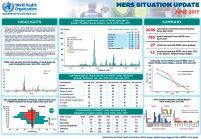 Read the MERS situation update for January 2019
Read the MERS situation update for January 2019- At the end of January 2019, a total of 2298 laboratory-confirmed cases of Middle East respiratory syndrome (MERS), including 811 associated deaths (case–fatality rate: 35.2%) were reported globally; the majority of these cases were reported from Saudi Arabia (1915 cases, including 735 related deaths with a case–fatality rate of 38.3%).
- During the month of January, a total of 19 laboratory-confirmed cases of MERS were reported globally; 14 of the cases were reported from Saudi Arabia with 3 associated deaths and 5 from Oman with 2 associated deaths. Of the cases reported from Saudi Arabia, 3 household clusters were reported with a total of 8 cases. The cluster reported from Oman included 5 young females (age range 30-59) living in the same region. Of these cases, 4 were secondary cases, identified through contact tracing of the 1st case detected on the 24th of January. Prior to this event, Oman has reported 11 laboratory-confirmed cases of MERS-CoV infection to WHO since 2012.
- The demographic and epidemiological characteristics of reported cases, when compared during the same corresponding period of 2013 to 2019, do not show any significant di erence or change. Owing to improved infection prevention and control practices in hospitals, the number of hospital-acquired cases of MERS has dropped significantly since 2015.
- The age group 50–59 years continues to be at highest risk for acquiring infection of primary cases. The age group 30–39 years is most at risk for secondary cases. The number of deaths is higher in the age group 50–59 years for primary cases and 70–79 years for secondary cases.
WHO Regional websites
Search
{{#data.error.root_cause}}
{{/data.error}}
{{^data.error}}
{{#texts.summary}}
[{{{type}}}] {{{reason}}}
{{/data.error.root_cause}}{{texts.summary}} {{#options.result.rssIcon}} RSS {{/options.result.rssIcon}}
{{/texts.summary}} {{#data.hits.hits}}
{{#_source.featured}}
FEATURED
{{/_source.featured}}
{{#_source.showImage}}
{{#_source.image}}
{{/_source.image}}
{{/_source.showImage}}
{{/data.hits.hits}}
{{{_source.title}}} {{#_source.showPrice}} {{{_source.displayPrice}}} {{/_source.showPrice}}
{{#_source.showLink}} {{/_source.showLink}} {{#_source.showDate}}{{{_source.displayDate}}}
{{/_source.showDate}}{{{_source.description}}}
{{#_source.additionalInfo}}{{#_source.additionalFields}} {{#title}} {{{label}}}: {{{title}}} {{/title}} {{/_source.additionalFields}}
{{/_source.additionalInfo}}







